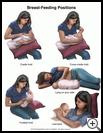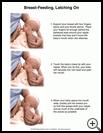
Breast-Feeding: Sore Nipples
Breast-feeding should be comfortable and enjoyable. Unfortunately, sore nipples are a common problem for breast-feeding mothers. Often mothers quit nursing their babies early because of sore nipples, but this doesn't have to happen. Sore nipples usually can be prevented or treated.
Mild nipple soreness at the start of feedings during the first few days of breast-feeding usually needs no treatment. However, nipple pain that is severe or lasts for a week or more is not normal and should be checked by your healthcare provider or a lactation consultant.
What causes sore nipples?
The most common cause of severe nipple soreness is the position of your baby's mouth on your breast. The size and shape of your nipples and your baby's mouth can affect how your baby latches on the breast. Also, your infant's sucking habits can cause nipple pain.
Other possible causes of nipple pain are
- a baby with tongue-tie
- an infection of the nipples (yeast or bacterial)
- a breast infection
- a spasm of the nipple
What are the problems caused by sore nipples?
If your baby is not latching on to your breast correctly, he may not be getting enough milk. Also, nipple pain may cause you to put off nursings or not let the baby suck long enough when he nurses. Sucking is important because this is what triggers your milk to flow (called the let-down reflex). Nipple pain can cause a drop in your milk supply. As a result, your baby may not gain weight well. Sore nipples and low milk supply problems often go hand-in-hand.
How are sore nipples treated?
The following guidelines should help your nipples feel better within a day or so.
- Make sure your baby is positioned correctly to nurse.
First, support your breast. With one hand, put 4 fingers below your breast and your thumb on top (C-hold). Or you can support your breast by rotating your hand into a U-hold, with your fingers and thumb on either side of your breast. Your fingers should be on the outside of the areola (the darkened area around the nipple) so that they won't touch your baby's mouth when he attaches.
Your baby should get a good, deep latch. Use the football hold or cross-cradle hold so that you have more control of baby's head. With your hand, hold the back of the baby's head, his neck, and upper back and shoulders. Your fingers will be behind his ears. Lightly stroke your baby's upper lip with your nipple until he opens wide (like a yawn). Quickly move the baby onto your breast, so that his chin and lower jaw touch the breast first. His head is tilted back slightly as he comes onto the breast. This results in an off-center latch, with his upper lip closer to the top of the nipple, and the lower lip further from the bottom of the nipple. The baby will be able to get milk more easily and cause you less pain.
- Do not let your baby take only the tip of your nipple. Make sure the baby gets enough of the lower part of the areola in his mouth. Not doing so is a common cause of sore nipples.
- During feeding, support your breast from below so the nipple and areola aren't pulled out of your baby's mouth by the weight of the breast.
- Make sure your baby is facing you.
- Begin a feeding on the less sore nipple to trigger your let-down reflex and start milk flowing.
Babies suck harder at the beginning of feedings. After your baby has nursed briefly and milk flow has begun, move her to the second breast with the sore nipple. This should make nursing more comfortable because the baby will suck less vigorously once milk starts to flow. As soon as possible, once the nipple soreness is gone, alternate the breast you start each feeding with to prevent a lopsided milk supply.
- Keep your nipples dry.
If you wear breast pads, change them as soon as they get wet. Gently pat your nipples dry with a clean cloth after nursing. Wash your nipples with water (no soap) when you bathe. Air dry your breasts. Don't dry your nipples too much. Too much dryness can irritate the skin.
At the end of each feeding, put a thin coating of USP Modified Lanolin (medical grade) on your nipples. This will keep the skin from getting too dry. This purified lanolin product can be bought from most places that rent breast-pumps.
- If you have cracks or other breaks in the skin, keep your nipples covered with a soothing ointment.
USP Modified Lanolin (medical grade) is best. Put a fresh coating on your nipples after each feeding. Also, wearing wide-based breast shells over your nipples between nursings can reduce the discomfort and speed up healing by preventing direct contact with your bra. Hydro-gel pads may be worn on nipples to provide soothing, cooling relief.
- Use a pump to express your milk if the pain is so severe that you cannot nurse your baby.
You can stop nursing and pump milk for 2 to 3 days while your nipples heal. You can rent a hospital-grade electric pump for a short time to express your milk comfortably. Pumping is a good way to empty your breasts and maintain or increase your milk supply while your nipples heal. Other types of breast pumps generally are not as comfortable or effective as a rental hospital-grade electric pump.
To find where you can rent a pump, call Ameda at 1-866-992-6332 or Medela at 1-800-435-8316.
- Watch for signs of a breast infection.
A cracked nipple may increase your risk for a breast infection (mastitis). Check your nipples for any signs of infection. The signs are described below.
When should I call the healthcare provider?
Call your immediately if:
- You have any of the following symptoms in addition to sore nipples: chills, fever, headache, flulike symptoms, lump in the breast, or pain or redness in your breast.
Call your healthcare provider or lactation consultant during office hours if:
- Your nipples sting or burn and you have shooting pains in your breast, especially after nursing.
- The nipple pain keeps you from nursing long enough to trigger your let-down reflex.
In this case, you may need to take pain medicine.
Call your baby's doctor during office hours if:
- Your baby is not satisfied after most nursings.
Your baby may not be satisfied because your milk supply is low or because your baby is not emptying your breasts. After weighing your baby, the doctor can decide whether you need to change your feeding schedule or offer your baby extra breast milk or formula. You may need to use an electric pump for a short time to pump out any milk left after nursings. Pumping will help increase your milk supply.
- Your nipples have a yeast infection, you see white patches in your baby's mouth, or your baby has had a diaper rash for 3 or more days.
Last modified: 2011-11-28
Last reviewed: 2011-11-28


